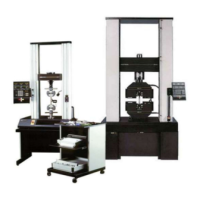Area Compensation
Description
The use of area compensation when testing specimens of
different cross-sectional area allows the load signal to be
calibrated in terms of stress, or similar units relating
force and specimen size. Stress is defined as the load on
a specimen divided by the original cross-sectional area
of the specimen. Other applications relating force and
specimen size where area compensation could be used,
include the testing of yarn or fiber to determine tenacity
in grams per denier.
In a Series 4400 system, area compensation values are
entered as a base number (mantissa) and an exponent us-
ing two key sequences, as described in Chapter 5. In-
creasing the mantissa values from between 1.000 to
9.999 proportionally decreases the sensitivity of the load
weighing system. For example, increasing the value
from 1.000 to 2.000 decreases load sensitivity by
1
/
2
,so
that twice as much loading on the test specimen will be
required for full scale stress response. The load-stress re-
lationship is expressed by the formula:
L = S x A or S = L/A
where (in English units, for example)
L = Load in pounds
S = Stress in psi
A = Cross-sectional area (in
2
)
When an area compensation value is entered that corre-
sponds to the cross-sectional area of a specimen, the
load channel gain is divided by the mantissa; that is, by
Area Compensation M10-94400-1
A-10

